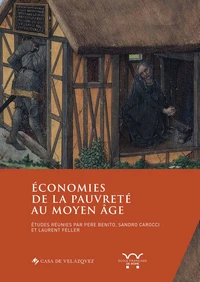Social Mobility in Medieval Italy (1100-1500)
Par : ,Formats :
- Paiement en ligne :
- Livraison à domicile ou en point Mondial Relay entre le 5 août et le 12 aoûtCet article sera commandé chez un fournisseur et sera expédié 6 à 12 jours après la date de votre commande.
- Retrait Click and Collect en magasin gratuit
- Livraison à domicile ou en point Mondial Relay entre le 5 août et le 12 août
- Réservation en ligne avec paiement en magasin :
- Indisponible pour réserver et payer en magasin
- Nombre de pages426
- PrésentationRelié
- FormatGrand Format
- Poids0.83 kg
- Dimensions16,2 cm × 23,7 cm × 3,4 cm
- ISBN978-88-6728-820-5
- EAN9788867288205
- Date de parution01/01/2018
- CollectionViella Historical Research
- ÉditeurViella
Résumé
This volume aims to investigate the complex theme of social mobility in medieval Italy both by comparing Italian research to contemporary international studies in various European contexts, and by analysing a broad range of themes and specific case studies. Medieval social mobility as a European phenomenon, in fact, still awaits a systematic analysis, and has seldom been investigated isexta propria principia in social, political and economic history.
The essays in the hook deal with a number of crucial problems : how is social mobility investigated in European and Mediterranean contexts ? How did classic mobility channels such as the Church, officialdom, trade, the law, the lordship or diplomacy contribute to shaping the many variables at play in late medieval societies, and to changing — and challenging — inequality ? How did movements and changes in social spaces become visible, and what were their markers ? What were the dynamics at the heart of the processes of social mobility in the many territorial contexts of the Italian peninsula ?
The essays in the hook deal with a number of crucial problems : how is social mobility investigated in European and Mediterranean contexts ? How did classic mobility channels such as the Church, officialdom, trade, the law, the lordship or diplomacy contribute to shaping the many variables at play in late medieval societies, and to changing — and challenging — inequality ? How did movements and changes in social spaces become visible, and what were their markers ? What were the dynamics at the heart of the processes of social mobility in the many territorial contexts of the Italian peninsula ?
This volume aims to investigate the complex theme of social mobility in medieval Italy both by comparing Italian research to contemporary international studies in various European contexts, and by analysing a broad range of themes and specific case studies. Medieval social mobility as a European phenomenon, in fact, still awaits a systematic analysis, and has seldom been investigated isexta propria principia in social, political and economic history.
The essays in the hook deal with a number of crucial problems : how is social mobility investigated in European and Mediterranean contexts ? How did classic mobility channels such as the Church, officialdom, trade, the law, the lordship or diplomacy contribute to shaping the many variables at play in late medieval societies, and to changing — and challenging — inequality ? How did movements and changes in social spaces become visible, and what were their markers ? What were the dynamics at the heart of the processes of social mobility in the many territorial contexts of the Italian peninsula ?
The essays in the hook deal with a number of crucial problems : how is social mobility investigated in European and Mediterranean contexts ? How did classic mobility channels such as the Church, officialdom, trade, the law, the lordship or diplomacy contribute to shaping the many variables at play in late medieval societies, and to changing — and challenging — inequality ? How did movements and changes in social spaces become visible, and what were their markers ? What were the dynamics at the heart of the processes of social mobility in the many territorial contexts of the Italian peninsula ?






